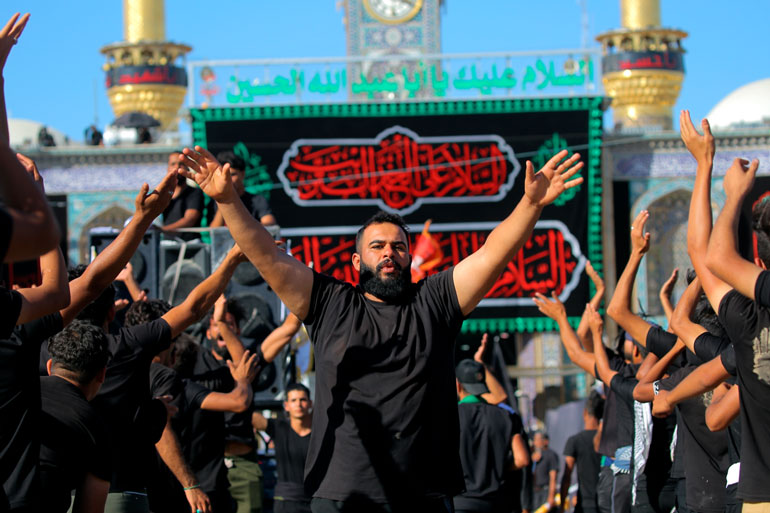Question: Why do Shias take the walk to visit Imam Hussain (pbuh) on Arbaeen?
Answer:
1- The importance of pilgrimage and its philosophy One of the recommended acts of worship in Islam is pilgrimage. The literal meaning of pilgrimage is visiting; and it includes visiting a person both during their lifetime as well as after their death. “Pilgrimage” in religious terms means to be before the religious leaders or by their graves to express devotion and respect with the intention of obeying the divine rituals. It is clear that one of the ways to express love to family or friends is to visit them, or if they have passed away, to visit their graves. We know that the Holy Prophet (pbuh) and the pure Imams (pbut) are the most beloved servants of God. Pilgrimage is one of the best ways to show love to these holy characters. According to authentic hadiths, visiting the Holy Prophet (pbuh) and the infallible imams (pbut) has many other effects and blessings in addition to expressing love.Infallible imams (pbut) have special attention towards those who visit their graves. According to a statement by Imam Reza (pbuh), pilgrimage is one of the examples of fulfilling the covenant with the Imams (pbut). Whoever visits the imams (pbut) willingly while acknowledging their wishes, the imams will be his intercessors on the Day of Judgment. 1
2- The virtue of visiting Imam Hussain (pbuh) Although the pilgrimage of all the Imams (pbut) has many remuneration and rewards, among the other children of the Holy Prophet (pbuh), the pilgrimage of Sayyed al-Shohada (PBUH) in Karbala has a special and privileged position and importance. In the hadiths passed down from the infallibles (pbut), extraordinary rewards and numerous effects and blessings have been mentioned for the pilgrimage of Imam Hussain 2 (pbuh), among them the removal of evils and the increase of the pilgrim’s sustenance. 2
3- Visiting Imam Hussain (pbuh) on Arbaeen Pilgrimage to Imam Hussain (peace be upon him) is always recommended at any time and has many effects and blessings. But at certain times and occasions, it is emphasized more and a special reward is promised for it; including the mid-Rajab, the mid-Sha’ban, the day of Arafah, etc. Among these occasions, the pilgrimage of Sayyed al-Shohada (PBUH) on the day of Arbaeen (ie forty days after the anniversary of his martyrdom) has had a special importance and place among Shias. According to historical reports, Jabir bin Abdullah Ansari, a great companion of the Prophet of Islam (pbuh) was honored to visit Imam Hussain (pbuh) on the day of Arbaeen. From that time on, Shias have always paid special attention to reach Karbala on the day of Arbaeen and visit that Imam closely. In a narration by Imam Hasan Askari (pbuh), he listed five signs for a believer, one of which is the Arbaeen pilgrimage. 3 Also, Imam Sadiq (pbuh) taught a special pilgrimage prayer for this day, which shows the granting of visiting Imam Hussain (pbuh) on this day. 4&5
4- Walking and pilgrimage etiquette In addition to the temporal and spatial aspects of pilgrimage, mentioned above, there are rituals and recommendations to it. One of the rituals of visiting Imam Hussain (pbuh) for which a great reward is considered, is walking to visit him. Going on pilgrimage on foot is a kind of homage and a sign of submission. In the words of the infallibles (pbut), great rewards are mentioned for doing the pilgrimage of Sayyed al-Shohad (pbuh) on foot. Imam Sadiq (pbuh) said: “A person who walks out of their house with the intention of visiting the grave of Hussain bin Ali (pbuh), Allah S.W.T will record one good act for each step he takes and erase one sin from them.” 6
5- Continuation of the tradition of Arbaeen pilgrimage on foot According to these special emphasis, the tradition of going on the pilgrimage of Sayyed al-Shohad (pbuh) on Arbaeen on foot was gradually shaped, and although it was accompanied by many ups and downs due to the pressures that occasionally arose by the oppressive governments, it did not fade away as time passed.
Every year, Shias from all around the world come to the land of Iraq with enthusiasm, and join the huge number of pilgrims of Hussein (pbuh). These lovelorn and eager people take each step of the way to visit their master and approach the shrine of Imam Hussain (pbuh) on foot. During the journey, whenever they are reminded of the sufferings of Sayyed al-Shahda (pbuh) and the captives, women and children of the Holly Prophet (pbuh), they feel sad and sympathize with them, and occasionally shed tears over the exile and oppression of these loved ones.
——————————————————————————————————
References :
[1] Kafi / Vol. 4 / p. 567
[2] Kamel al-Ziyarat / Nass / 151
Imam Baqir, peace be upon him, said :
“مُرُوا شِيعَتَنَا بِزِيَارَةِ قَبْرِ الْحُسَيْنِ ع فَإِنَّ إِتْيَانَهُ يَزِيدُ فِي الرِّزْقِ وَ يَمُدُّ فِي الْعُمُرِ وَ يَدْفَعُ مَدَافِعَ السَّوْءِ”
“Order our Shias to visit the grave of Hussain bin Ali, peace be upon him; Because the pilgrimage of that Imam increases sustenance and prolongs life and repels things that attract evil.”
[3] Kitab Al-Mazar – Manasik Al-Mazar (Lelmofid) / p. 53
[4] Qabsat Min Elm al-Rijal/Vol.3/p. 656
[5] The famous pilgrimage to Arbaeen begins with these verses:
“اَلسَّلامُ عَلی وَلیِّ اللهِ وَ حَبیبِهِ، اَلسَّلامُ عَلی خَلیلِ اللهِ وَ نَجیبِهِ ….”
“Peace be upon God’s friend and beloved, peace be upon God’s friend and benefactor….”
[6] Kamel Al-Ziyarat / p. 132


